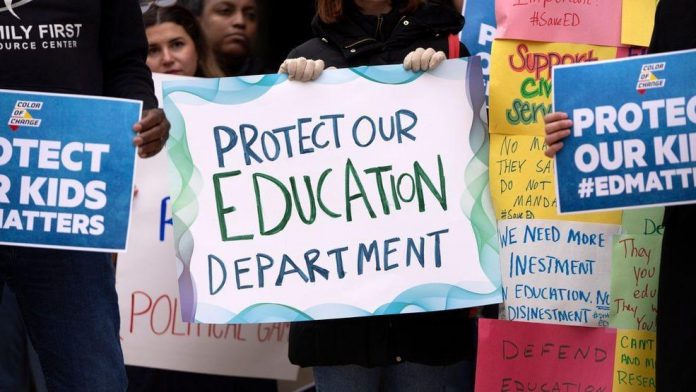
Deja Geter
Staff writer
On Friday, President Donald Trump issued a controversial executive order with the goal of eliminating the United States Department of Education sending shockwaves through the country- especially among college students. This sparked conversations across the nation regarding the impact on higher education funding, control, and accessibility.
Republicans have hailed the directive, which seeks to shift federal education control to individual states, as a step forward minimizing federal overreach. However, detractors fear that it will exacerbate educational disparities and put lower-income students at danger.
“This is about giving power back into the states,” Trump stated during the signing ceremony. “For too long, the Department of Education has stood in the way of progress, imposing one-size-fits-all policies that stifle innovation. It’s time to let the states decide what’s best for their students.”
The announcement sparked immediate outrage among some college students at Jackson State University, many of whom are concerned about the future of federal financial aid programs and academic requirements.
Myron Simmons, a journalism and media studies major from Washington, D.C., expressed his concern about the uncertainty of funds for education.
“Without federal control, I am concerned that the states will start cutting back on financial aid,” Simmons explained. “I do rely on federal Pell Grants, and if those are reduced or gone all together, it will be almost impossible for me to stay in school.”
The executive order seeks to decrease federal intervention by handing major educational programs and budget administration to the state governments. Proponents believe this will allow states more flexibility, while opponents worry it will lead to inconsistency and disparity in educational standards across the country.
Kennedy Neal, a biology/pre-med major also from Washington, D.C., was also concerned about the dismantling of the Department of Education (DOE).

“On one hand, giving states more autonomy may assist in customizing education to the individual requirements of local populations, which appears to be desirable. However, there is considerable concern that it may result in quality discrepancies, particularly for pupils in underserved states. It could wind up making things more uneven, which is concerning for children who are already facing enough obstacles in their schooling,” said Neal.
The breakdown of the DOE might fundamentally alter how public education is funded and managed. Title I funding for low-income schools, special education services under the Individuals with Disabilities Education Act (IDEA), and federal payments for higher education may be reformed or transferred to state agencies.
Dajah Edelin, a health administration major, is concerned that the order could affect access to financial aid in the future.
“As a student at an HBCU, most of my aid relies on Pell Grants to cover my tuition. If the federal government steps back, I’m afraid there will be fewer protections for students like me. Some states might have different priorities and students in neglected areas might lose out,” said Edelin.
Despite the executive order, effectively abolishing the DOE needs congressional approval, therefore the order is mostly symbolic unless additional legislative action is achieved. Legal professionals anticipated strong opposition from Democrats and some moderate Republicans, as well as prospective challenges from the Civil Rights Organization.
Trump’s executive order marked a fundamental shift in the federal government’s role in education. While some kids and educators applaud the decision as a step forward for more local authority, others fear it would exacerbate inequity and limit access to essential federal protections.

